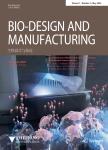Development of a 3D subcutaneous construct containing insulin-producing beta cells using bioprinting
Development of a 3D subcutaneous construct containing insulin-producing beta cells using bioprinting作者机构:Department of Molecular MedicineCollege of MedicineGachon University155Gaetbeol-roYeonsu-kuIncheonRepublic of Korea Department of Health Sciences and TechnologyGAIHSTGachon University155Gaetbeol-roYeonsu-kuIncheonRepublic of Korea College of PharmacyGachon University191Hambangmoe-roYeonsu-kuIncheonRepublic of Korea Department Thoracic and Cardiovascular SurgeryGachon University Gil Medical CenterCollege of MedicineGachon University21Namdong-daero 774 beon-gilNamdong-guIncheonRepublic of Korea
出 版 物:《Bio-Design and Manufacturing》 (生物设计与制造(英文))
年 卷 期:2022年第5卷第2期
页 面:265-276页
核心收录:
学科分类:0831[工学-生物医学工程(可授工学、理学、医学学位)] 0710[理学-生物学] 0817[工学-化学工程与技术] 08[工学] 0807[工学-动力工程及工程热物理] 0805[工学-材料科学与工程(可授工学、理学学位)] 0802[工学-机械工程] 0836[工学-生物工程] 0811[工学-控制科学与工程] 080201[工学-机械制造及其自动化]
基 金:supported by the Korea Health Industry Development Institute(KHIDI)funded by the Ministry of Health&Welfare,Republic of Korea(No.HH21C0011) Gachon University Gil Medical Center(No.FRD 2021-02)
主 题:3D bioprinting Subcutaneous construct Type 1 diabetes Insulin Beta cells
摘 要:Type 1 diabetes is caused by insulin deficiency due to the loss of beta cells in the islets of *** severe cases,islet transplantation into the portal vein is ***,due to the loss of transplanted islets and the failure of islet function,the 5-year insulin independence rate of these patients is50%.In this study,we developed a long-term,insulin-secreting,3 Dbioprinted construct implanted subcutaneously with the aim of preventing islet *** bioprinted construct was fabricated by the multi-layer bioprinting of beta-cell(mouse insulinoma-6:MIN-6)-encapsulated alginate bioink and poly(caprolactone)biodegradable polymer.A glucose response assay revealed that the bioprinted constructs proliferated and released insulin normally during the 4-week in vitro *** MIN-6 generated clusters with a diameter of 100-200μm,similar to the original pancreatic islets in the *** an in vivo study using type 1 diabetes mice,animals implanted with bioprinted constructs showed three times higher insulin secretion and controlled glucose levels at 8 weeks after *** the implanted,bioprinted constructs had a positive effect on insulin secretion in the experimental animals,the survival rate of the implanted group(75%)was three times higher than that of the non-implanted group(25%).The results suggest that the proposed,3 D-bioprinted,subcutaneous construct can be a better alternative to portal vein islet transplantation.



